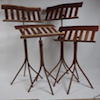I am building my first set of stairs and need some help with some general questions. I already have a rough set of stairs that go from the main floor down to the basement with a 135deg turn after 2steps down and then two winders (67.5degrees) and then 9 straight steps to the basement floor.
Stairs are in a stair well finished with drywall on each side with exposed studs on both sides below the stringer level. I want to add a 2"x4" on the lower outside of each stringer to fasten to the studs on either side of the stair well. I then want to slide a 3/4" baltic birch plywood skirt board between the drywall and the stringers that I will secure to the drywall with brads. The stair treads will be 1-1/4" cherry and the risers will be 3/4" baltic birch plywood.
Q1.) What is the best way to attach the stringers to the stair well studs? I was thinking of using 2" brads to attach 2"x4" to the bottom of the stringers temporarily and then drive two 5-1/4" x 5/16" GRK RSS screws thru that assembly into each of the wall studs in the stair well to secure the stairs. I don't own a nailer and already have the 5" screws on hand.
Q2.) I want to protect the bottom of the stringer from water damage so wanted some ideas on how to do that. So I thought about using a couple of pieces of treated 2"x4"s that I would attach to the basement cement floor with three TAPcons (2-1/2") each and then cut the stringer by 1-1/2" to accommodate the height difference. then I would attach the stringers to the treated 2"x4"s using right angle brackets (Simpson, etc) to secure the stringers to the ground.
Q3.) Should I glue the skirt board to the wall or will the brads be enough to hold it in place? I just don't want those skirt boards coming off the wall in time.
Q4.) How should I do the support for the winder steps on the wide side? I was thinking of using regular stringer on the narrow side and then use two pieces of 2"x12" cut down to stair unit height and unit run length that attach directly to the wall studs spaced with 2"x4"s at the bottom to keep the same offset from the wall studs.
Please let me know if you need more clarification.
Thanks,
Frank




 Reply With Quote
Reply With Quote




